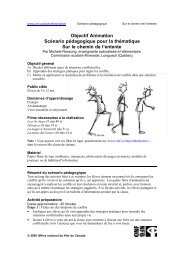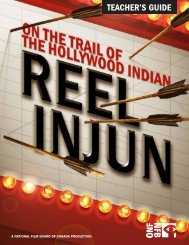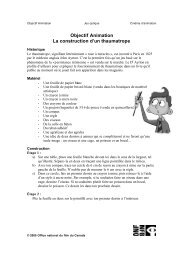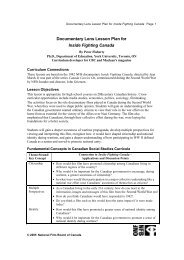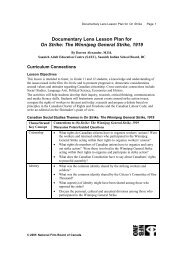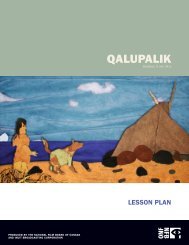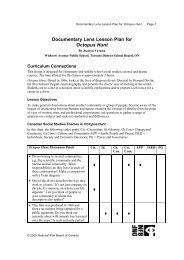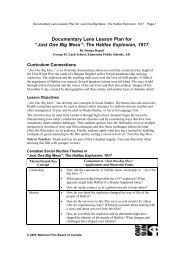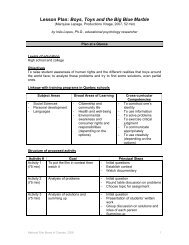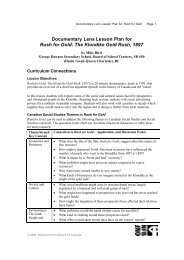Study guide - Office national du film du Canada
Study guide - Office national du film du Canada
Study guide - Office national du film du Canada
- No tags were found...
You also want an ePaper? Increase the reach of your titles
YUMPU automatically turns print PDFs into web optimized ePapers that Google loves.
STUDY GUIDEFEDERATION OF NATIVE PEOPLESBuilt on the teachings of the Shawnee “Prophet” Lalawethika, Chief Tecumseh’sbrother, the Federation of Native Peoples sought to stop the selling of Indianland to America before and <strong>du</strong>ring the War of 1812. Though its memberswere mostly Shawnee, its leader, Chief Tecumseh, held influence in most nativenations throughout the northwestern United States. As a result, he was ableto recruit members from tribes including the Iroquois, Chickamauga, Ojibway,Mascouten and Potawatomi. However, gaining support was often difficult.Tecumseh’s proposed unification of all Indian nations would undermine theauthority of indivi<strong>du</strong>al chiefs and elders. Many nations and tribes felt themselvesto be on better terms with the Americans and allied with them againstthe Federation. Chief Black Hoof, also Shawnee, was a staunch opponent.Rather than unite with Tecumseh’s cause, Black Hoof urged his people towardcultural adaptation—adoption of the American way of life. At the peak of itsstrength, Tecumseh’s Federation numbered over 5,000 warriors. But with hisdeath in the Battle of the Thames in late 1813, it disintegrated and was neverre-established.ABOUT THE HISTORICAL EVENTSTHE BATTLE OF TIPPECANOE (NOVEMBER 7, 1811)The Battle of Tippecanoe, or “Prophetstown,” took place at a native settlementfounded by Tecumseh and his younger brother, the “Prophet” Lalawethika, onthe banks of the Wabash River in Indiana Territory. Residents of Tippecanoehad set aside tribal differences in order to work towards an Indian confederacy.By 1811, hundreds had flooded into the village to protest Americanland grabs of traditional territory, and Tecumseh had turned to the British forsupplies to feed his rapidly growing community. This enraged Indiana GovernorWilliam Henry Harrison, who resented British involvement and viewed thenatives as a threat to his expansionist policies. Tecumseh was a fierce warrior,but he was not foolhardy and realized the time had not yet come for all-outwar. Instead, he travelled south for a parlay with the Creek Nation, seekingto expand his confederacy. Taking advantage of Tecumseh’s absence, Harrisonplanned a sunrise attack on Tippecanoe for November 7, 1811. News of theplan reached Lalawethika on November 6, however, and he mobilized the500 warriors at Tippecanoe into a pre-dawn ambush. Although the warriorsinflicted heavy casualties, they were ultimately pushed back. Stunned by hislosses however, Harrison went on the defensive, rather than attacking thevillage immediately. By November 8, when an American patrol approachedTippecanoe, it was found abandoned. Harrison ordered the village burned andthe granary plundered. In the spring of 1812, Tecumseh returned and, standing“upon the ashes of [his] home,” he “summoned the spirits of the braveswho had fallen in their vain attempts to protect their homes from the graspinginvader.” This battle left him little choice but to ally himself with Britain in thecoming war. For his part, Harrison called for vengeance through congressmenlike Henry Clay and Felix Grundy, who used Tippecanoe as a rallying cry forwar against Britain.AMERICAN DECLARATION OF WAR (JUNE 18, 1812)One of the most memorable statements—at least among Canadians—onthe subject of America’s declaration of war against the British Empire camefrom Thomas Jefferson: “The conquest of the <strong>Canada</strong>s will be a mere matterof marching.” With most of Britain’s trained soldiers already fighting Napoleonin France, much of the American invading force believed <strong>Canada</strong> to belargely undefended and thus easily overtaken. So, fuelled by the near-religiousconviction of America’s “Manifest Destiny” and Senator Henry Clay’s publicoutrage over the British impressment of American citizens, America went towar in <strong>Canada</strong>. Conquest proved less straightforward than those in powerhad anticipated, however. The sheer size of <strong>Canada</strong> made the question ofwhere to begin marching (and how to distribute forces) difficult to answer. TheAmericans also did not anticipate such a large and willing contingent of Indianfighters and Canadian militiamen.GENERAL WILLIAM HULL INVADES SANDWICH (JULY 12, 1812)By 1812, most of the American public agreed with former President ThomasJefferson that invading the <strong>Canada</strong>s would be “a mere matter of marching.”It had been decided that a primary contingent would advance on Montreal, asecond would push up the Niagara River and a third would sweep out of FortDetroit into the heart of Upper <strong>Canada</strong>. Michigan Territory Governor WilliamHull, who was stationed at Fort Detroit, was in charge of the Upper <strong>Canada</strong>campaign. Hull had little enthusiasm for his command and botched several aspectsof his campaign. The British uncovered his entire invasion plan and capturedmany of his army’s supplies when they took command of the Americanschooner Cayuga, depriving Hull of the element of surprise. He did manageto cross the Detroit River and temporarily occupy the French Canadian villageof Sandwich. Fearing the natives would attack, Hull sent fiery missives to thewhite settlers around Sandwich, threatening to kill any who sided with theIndians. Hull’s worst fears were realized when Tecumseh and a raiding partyambushed a supply column on its way to Fort Detroit on August 5, 1812. Threedays later, Hull ordered Sandwich abandoned and withdrew his army behindthe walls of Fort Detroit.THE ATTACK ON FORT DETROIT (AUGUST 16, 1812)Major-General Isaac Brock’s attack on Fort Detroit is the stuff of legend. Outmannedand outgunned, the first British attempt to take the Fort had beenessentially useless. Then, with the arrival of Shawnee Indian Chief Tecumsehand several hundred of his warriors, the scales began to tip and Brock had anidea: he ordered his trained soldiers to share their uniforms with the regularmilitiamen; marching them back and forth out of firing range, he made itseem that his forces were twice as large. Then, Tecumseh did the same withhis warriors, making sure that American General William Hull got a good lookat the numbers. Finally, Brock gave Hull three hours to surrender the Fort. Hullfell for the trick and surrendered Fort Detroit with no loss of life on either side.QUEENSTON HEIGHTS (OCTOBER 13, 1812)Queenston Heights had sprung up as a waypoint where boats could unloadcargo to be transported throughout Niagara Falls by horse and cart. Becauseof its significance in the movement of supplies, attacking Queenston wouldeffectively cut Lower <strong>Canada</strong> and Upper <strong>Canada</strong> off from one another. TheAmericans attempted to gain ground on the Canadian side of the Niagara butultimately failed <strong>du</strong>e to a highly disorganized campaign and quarreling Americanleadership. The Canadians were led by Major-General Isaac Brock after hisvictorious return from Fort Detroit. Brock was awakened by American artilleryfire and rushed towards Queenston Heights while gathering his troops. Asthey climbed the steep slope of the heights towards the Americans, they weremet with fire, and Brock was hit in the wrist by a musket ball. With his swordheld high, Brock continued to move his troops towards the Americans; but asthey charged forward, Brock was hit again, this time just above the heart, anddied. With Brock’s death, Major General Roger Sheaffe took charge, and histroops continued to lunge at the Americans. The British and Canadians wereoutnumbered, but a strong British artillery and demoralized American soldiers,unwilling to fight on foreign land, led to the surrender of the Americans and adecisive and important victory for the British and Canadians.— 4 —




